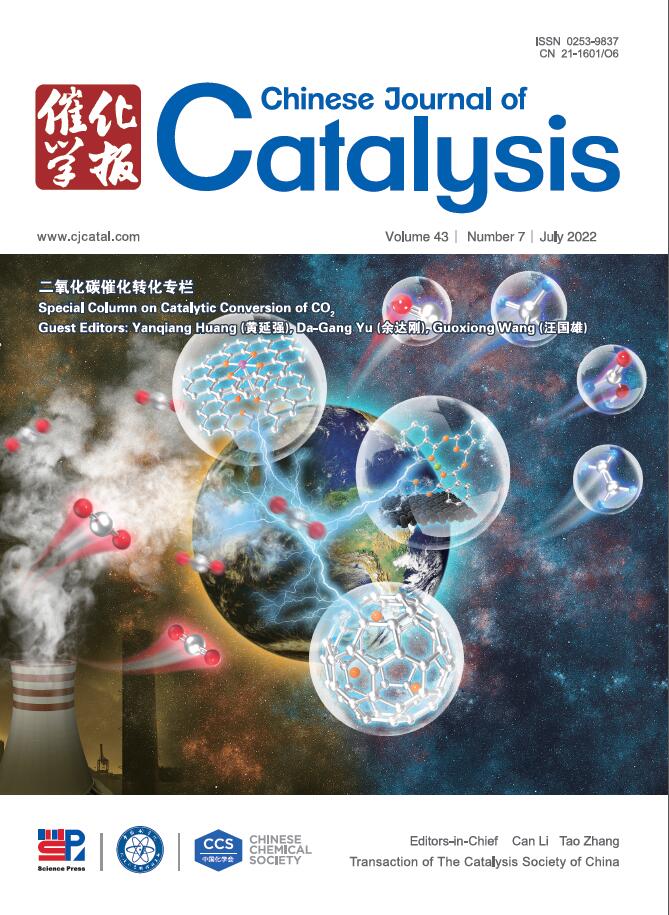基于cu基高熵合金的高性能CO2还原催化剂的图神经网络驱动预测
IF 15.7
1区 化学
Q1 CHEMISTRY, APPLIED
引用次数: 0
摘要
高熵合金(HEA)具有可调的成分和表面结构,能够产生新的活性位点,从而提高可再生能源应用中的催化性能。然而,固有的表面复杂性和元素偏析趋势导致了块体和表面成分之间的差异,这给通过密度泛函理论进行直接研究带来了挑战。为了解决这个问题,我们采用了蒙特卡罗模拟与分子动力学相结合的方法来模拟包括铜、银、金、铂、钯和铝在内的多种元素的表面偏析。为了捕捉表面位点特征与多位点二氧化碳还原中间产物自由能之间的相关性,我们设计了一个图神经网络,将吸附剂转化为其质量中心的假原子。该模型得出的 C2 中间体自由能的平均绝对误差为 0.08-0.15 eV,从而实现了精确的位点活性量化。结果表明,增加铜、银和铝的浓度可显著提高 CO 和 C2 生成的活性,而金、钯和铂则表现出负面影响。通过筛选稳定的组成空间,预测了 CO、HCOOH 和 C2 产物的有前途的 HEA 块状组成,与纯铜催化剂相比,它们具有更优越的催化活性。本文章由计算机程序翻译,如有差异,请以英文原文为准。
Graph neural network-driven prediction of high-performance CO2 reduction catalysts based on Cu-based high-entropy alloys
High-entropy alloy (HEA) offer tunable composition and surface structures, enabling the creation of novel active sites that enhance catalytic performance in renewable energy application. However, the inherent surface complexity and tendency for elemental segregation, which results in discrepancies between bulk and surface compositions, pose challenges for direct investigation via density functional theory. To address this, Monte Carlo simulations combined with molecular dynamics were employed to model surface segregation across a broad range of elements, including Cu, Ag, Au, Pt, Pd, and Al. The analysis revealed a trend in surface segregation propensity following the order Ag > Au > Al > Cu > Pd > Pt. To capture the correlation between surface site characteristics and the free energy of multi-dentate CO2 reduction intermediates, a graph neural network was designed, where adsorbates were transformed into pseudo-atoms at their centers of mass. This model achieved mean absolute errors of 0.08–0.15 eV for the free energies of C2 intermediates, enabling precise site activity quantification. Results indicated that increasing the concentration of Cu, Ag, and Al significantly boosts activity for CO and C2 formation, whereas Au, Pd, and Pt exhibit negative effects. By screening stable composition space, promising HEA bulk compositions for CO, HCOOH, and C2 products were predicted, offering superior catalytic activity compared to pure Cu catalysts.
求助全文
通过发布文献求助,成功后即可免费获取论文全文。
去求助
来源期刊

Chinese Journal of Catalysis
工程技术-工程:化工
CiteScore
25.80
自引率
10.30%
发文量
235
审稿时长
1.2 months
期刊介绍:
The journal covers a broad scope, encompassing new trends in catalysis for applications in energy production, environmental protection, and the preparation of materials, petroleum chemicals, and fine chemicals. It explores the scientific foundation for preparing and activating catalysts of commercial interest, emphasizing representative models.The focus includes spectroscopic methods for structural characterization, especially in situ techniques, as well as new theoretical methods with practical impact in catalysis and catalytic reactions.The journal delves into the relationship between homogeneous and heterogeneous catalysis and includes theoretical studies on the structure and reactivity of catalysts.Additionally, contributions on photocatalysis, biocatalysis, surface science, and catalysis-related chemical kinetics are welcomed.
 求助内容:
求助内容: 应助结果提醒方式:
应助结果提醒方式:


